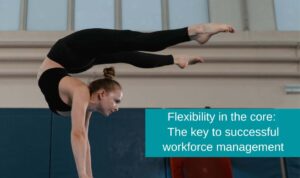In today’s dynamic business landscape, flexibility is no longer a luxury but an absolute necessity for your organisation’s success. Whether it’s managing project peaks, filling specialist roles, or ensuring agility in uncertain times, the deployment of flexible labour – via temporary staffing agencies, secondment, or freelance (IR35 compliant) recruitment – has become a crucial strategy.
However, optimising this flexible workforce requires more than simply placing a request with an external party. It demands a fundamental shift from a transactional client-supplier relationship to a genuine partnership, built on mutual trust, open communication, and a shared focus on achieving the best outcomes.
The route to optimal results
What does such an optimal collaboration look like in practice? It’s an interplay of several key elements:
- Joint (tactical and strategic) planning: The foundation of a successful collaboration is laid early on. Instead of ad-hoc requests, hiring organisations share their anticipated flexible workforce needs at a strategic level with their preferred suppliers. This enables the supplier to source proactively, build talent pools, and thoroughly prepare for future requirements. Regular strategic reviews, discussing market trends and the organisation’s specific needs, are essential here.
- Transparent communication and clear expectations: Open and honest communication is the bedrock of any strong partnership. The hiring organisation shares not only the hard criteria of the vacancy (skills, experience, rate) but also the role’s context, team dynamics, and company culture. In turn, the supplier is transparent about their sourcing strategies, candidate availability, and realistic turnaround times. Clear Service Level Agreements (SLAs) with measurable KPIs ensure clear expectations on both sides.
- Integration and knowledge sharing: Successful collaboration extends beyond the exchange of job specifications and CVs. It involves a degree of integration, where the supplier gains a deeper understanding of the organisation, its processes, and its challenges. This can be facilitated through site visits, involving the supplier in internal meetings, on-site presence of the supplier’s team, and sharing feedback on placed candidates. This knowledge empowers the supplier to select candidates who not only possess the right skills but also demonstrate a strong cultural fit within the organisation.
- Mutual respect and trust: A partnership thrives on mutual respect and trust. The hiring organisation recognises the supplier’s expertise and efforts in identifying suitable candidates. The supplier feels valued and is seen as an extension of the internal HR team. This manifests in a constructive dialogue, jointly seeking solutions, and avoiding micromanagement.
- Focus on quality over pure cost reduction: While a competitive rate is important, it should never compromise candidate quality. A partnership aims to find the best long-term matches, resulting in higher productivity, reduced attrition, and ultimately a better return on investment. An excessive focus on the lowest price can lead to a race to the bottom, jeopardising candidate quality and supplier service levels.
- Continuous evaluation and improvement: A strong partnership is not static but evolves continuously. Regular review meetings, where both parties provide open feedback on the collaboration and performance, are crucial for ongoing improvement. This enables both organisations to learn from each other, optimise processes, and elevate the partnership to a higher level.
The benefits of mutual investment
Investing in building strong partnerships with your flexible workforce suppliers is not a one-sided effort but a strategic move that yields significant returns for both parties:
For the hiring organisation:
- Access to top talent: A deep collaboration enables the supplier to mobilise the best candidates within their network, often faster and more effectively than a purely transactional relationship.
- Shorter time-to-hire: Through continuous alignment and understanding of the organisational culture, the supplier can target their search more effectively and present suitable matches more quickly.
- Higher quality of candidates: A supplier with a strong understanding of the organisation can select candidates who not only possess the required skills but also align with the team and culture, leading to increased productivity and retention.
- More efficient processes: Streamlined communication and jointly aligned processes result in reduced administrative burden and more efficient handling of requests.
- Advisory role: A partner with in-depth knowledge of the organisation can provide valuable advice on the deployment of flexible labour in line with business objectives.
For the supplier:
- Predictable business: A strong relationship with a key account ensures a more stable and predictable flow of assignments.
- Deeper understanding of needs: Through close collaboration, the supplier gains a better understanding of the hiring organisation’s specific needs and challenges, enabling them to source and present more relevant candidates.
- Stronger market positioning: A successful, long-term partnership enhances the supplier’s reputation in the market.
- Opportunities for co-creation: A partnership provides scope for the joint development of innovative solutions in the field of flexible workforce provision.
Higher client satisfaction: A successful collaboration results in satisfied clients, forming the basis for a sustainable relationship.
The way forward: building sustainable partnerships
In an increasingly complex and rapidly changing labour market, embracing the power of collaboration is essential. By investing in building strong partnerships with your flexible workforce suppliers, you create a win-win situation that results in the optimal fulfilment of your flexible staffing needs, access to top talent, and enhanced organisational agility. Let us move beyond transactional relationships and together forge the path towards sustainable, successful partnerships.





